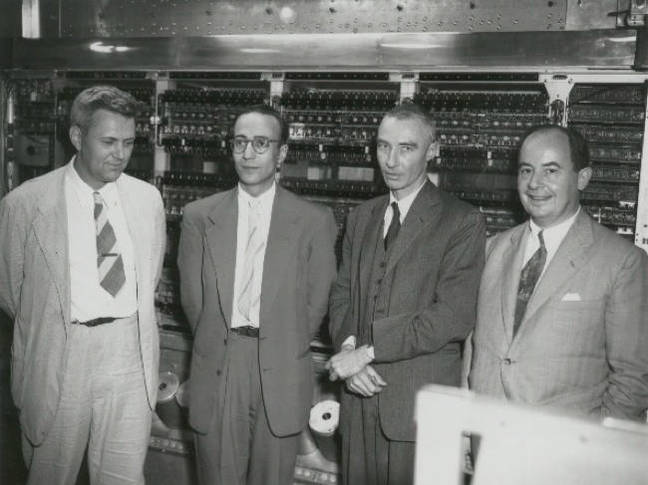This article is more than 1 year old
Fan belts only exist, briefly, in the intervals between stars
Reviewing the informative Turing’s Cathedral
Book review It's a full four years since it was published, but Reg contributor Geoffrey G Rochat has finally gotten around to reading George Dyson's worthy tome Turing’s Cathedral. He finds it's not just a Best Book list lurker, but something actually worth reading.
Ostensibly about the beginnings of computers, Turing’s Cathedral is chock-full of fantastic stuff about geniuses, near geniuses, damned fools (overlapping sets), Princeton, Brigadier General Mercer, hydrogen bombs, computerised weather forecasting, mathematical and electronic evolution, and the birth of the modern age. It begins thus:
In 1956, at the age of three, I was walking home with my father, physicist Freeman Dyson, from his office at the Institute for Advanced Study, when I found a broken fan belt lying in the road. I asked my father what it was.
"It’s a piece of the sun," he said.
My father was a field theorist, and protégé of Hans Bethe, former wartime leader of the Theoretical Division at Los Alamos, who, when accepting his Nobel Prize for discovering the carbon cycle that fuels the stars, explained that "stars have a life cycle much like animals. They get born, they grow, they go through a definitive internal development, and finally they die, to give back the material of which they are made so that new stars may live".
To an engineer, fan belts exist between the crankshaft and the water pump. To a physicist, fan belts exist, briefly, in the intervals between stars.”
Marvellous. The book covers a wide field, and is full of facts and lore from the earliest days of computing, and the Institute for Advanced Studies.
It’s devoted to the personalities involved. It concentrates on mathematician, physicist, inventor and polymath John von Neumann, of course, and his ideas on self-replicating machines, and also Klára von Neumann, who was not only Johnny’s wife, but also a brilliant programmer.
Also getting a well-earned mention are Edward Teller, Oswald Veblen, Stan Ulam and Julian Bigelow, the chief engineer of the IAS computer, who got utterly screwed by his IAS bosses, thereby setting the standard for all computer engineers to follow.

Left to right: Julian Bigelow, Herman Goldstine, J. Robert Oppenheimer, and John von Neumann at Princeton Institute for Advanced Study (Bigelow, own work)
The work provides many insights into the technologies involved in vacuum tube computers. For example, Chapter 7 is entitled “6J6", which was the seven-pin miniature dual triode that was the logical workhorse of the machine.
They were made in incredible quantities in WWII, and the IAS machine used them by the thousands as, by 1947, they were available at a cheap price as war surplus. But, being war surplus, they were somewhat dodgy in their characteristics, and the trick with the IAS was to get reliable performance out of questionable parts.
And, in a few precious sentences, written in passing, Dyson spills the beans on several tricks used in the IAS machine that I’ve been wondering about for years.
In 1955, IBM's RK Richards wrote Arithmetic Operations in Digital Computers, perhaps the earliest and best text on computers in the tube era. Richards taught computer engineering on the basis of modular logic design, the way it was done two decades later in the TTL era, rather than as circuit design.
He largely ignored circuit design in his 1955 book, leaving that for his Digital Computer Components and Circuits of 1957 (by which time he’d quit IBM and gone into consulting).
In the latter work he discusses many "systems of logic", by which he meant the circuit design philosophies and trade-offs of digital circuits made in different ways. For tube-based logic, the basic problem is that while the output plate circuit voltage of a gate swings from ground to perhaps 100 volts, the input control grid circuit voltage of a subsequent tube must swing from ground down to perhaps -20 volts. And it’s the level shifting that’s killer.
In conventional analog circuitry the level shifting is done by capacitive coupling. This works wonderfully well for audio amplifiers and radios and radars and television, as there one is dealing with more-or-less periodic signals whose average value is about zero – or can be processed as though they’re about zero and level shifted later, as DC restoration circuits in televisions do for video signals that get stomped on by superimposed sync pulses.
But digital circuits deal with largely aperiodic signals, which is not something that tube circuit designers were good at handling in the years during and after the last war.
One way out was to make digital circuits that ran, not on logic levels, but on logic pulses. Pulses pass through capacitors, and the capacitors take care of the level shifting problem. In this system of logic, logic signals are the presence or absence of pulses, and logic is performed on the coincidence, or lack thereof, of pulses.
This was how ENIAC and its ilk were designed, and strings of pulses can drive counters that perform arithmetic operations (albeit serially and slowly), so this would seem like a natural solution.
Unfortunately, pulses are delicate things, and when you pass them through capacitors you have to take great care to manage rise and fall times, otherwise they degrade to the point of not being able to trigger counters. That’s not helpful at all.
Also, pulse-based logic requires critical timing to make sure pulses meet (or not meet) when they’re supposed to. So, while pulse-based tube logic can be made to work, it’s a pain in the butt – particularly when you’re dealing with cheap war surplus components of doubtful provenance.
